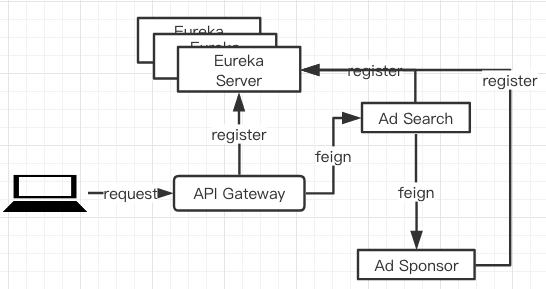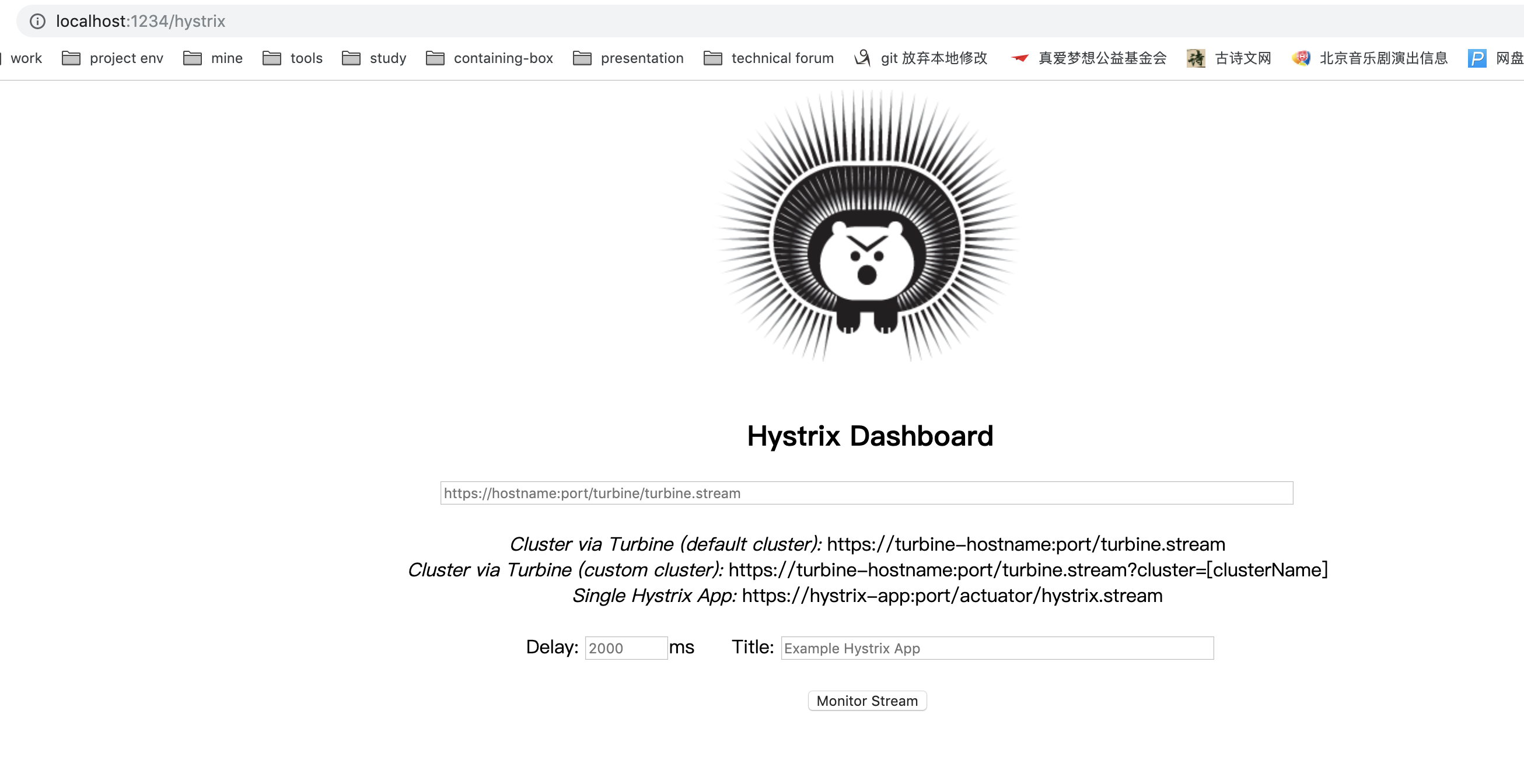在之前的18次文章中,我们实现了广告系统的广告投放,广告检索业务功能,中间使用到了 服务发现Eureka,服务调用Feign,网关路由Zuul以及错误熔断Hystrix等Spring Cloud组件。
简单调用关系:
但是系统往往都会报错,我们之前定义了一些容错类和方法,但是只是在控制台可以看到错误信息,我们想要统计一些数据,怎么才能更直观的看到我们的服务调用情况呢,接下来,和大家讨论一个新的熔断监控组件Hystrix Dashboard,顾名思义,从名字上我们就能看出来,它是监控的图形化界面。
Hystrix 在服务中的使用
结合openfeign使用
在我们实际的项目当中,使用的最多的就是结合FeignClient#fallback和Hystrix一起来实现熔断,我们看一下我们在mscx-ad-feign-sdk中的实现。
@FeignClient(value = "mscx-ad-sponsor", fallback = SponsorClientHystrix.class)
public interface ISponsorFeignClient {
@RequestMapping(value = "/ad-sponsor/plan/get", method = RequestMethod.POST)
CommonResponse<List<AdPlanVO>> getAdPlansUseFeign(@RequestBody AdPlanGetRequestVO requestVO);
@RequestMapping(value = "/ad-sponsor/user/get", method = RequestMethod.GET)
/**
* Feign 埋坑之 如果是Get请求,必须在所有参数前添加{@link RequestParam},不能使用{@link Param}
* 会被自动转发为POST请求。
*/
CommonResponse getUsers(@RequestParam(value = "username") String username);
}在上述代码中,我们自定义了一个feignclient,并且给了这个client一个fallback的实现类:
@Component
public class SponsorClientHystrix implements ISponsorFeignClient {
@Override
public CommonResponse<List<AdPlanVO>> getAdPlansUseFeign(AdPlanGetRequestVO requestVO) {
return new CommonResponse<>(-1, "mscx-ad-sponsor feign & hystrix get plan error.");
}
@Override
public CommonResponse getUsers(String username) {
return new CommonResponse<>(-1, "mscx-ad-sponsor feign & hystrix get user error.");
}
}这个fallback类实现了我们自定义的ISponsorFeignClient,那是因为fallback的方法必须和原始执行类的方法签名保持一致,这样在执行失败的时候,可以通过反射映射到响应的降级方法/容错方法。
在mscx-ad-search服务中,我们通过注入ISponsorFeignClient来调用我们的mscz-ad-sponsor服务。
@RestController
@Slf4j
@RequestMapping(path = "/search-feign")
public class SearchFeignController {
/**
* 注入我们自定义的FeignClient
*/
private final ISponsorFeignClient sponsorFeignClient;
@Autowired
public SearchFeignController(ISponsorFeignClient sponsorFeignClient) {
this.sponsorFeignClient = sponsorFeignClient;
}
@GetMapping(path = "/user/get")
public CommonResponse getUsers(@Param(value = "username") String username) {
log.info("ad-search::getUsersFeign -> {}", JSON.toJSONString(username));
CommonResponse commonResponse = sponsorFeignClient.getUsers(username);
return commonResponse;
}
}使用HystrixCommand
其实Hystrix本身提供了一种直接在方法中应用的方式,就是使用@ com.netflix.hystrix.contrib.javanica.annotation.HystrixCommand,我们看一下这个类的源码:
@Target({ElementType.METHOD})
@Retention(RetentionPolicy.RUNTIME)
@Inherited
@Documented
public @interface HystrixCommand {
...
/**
* Specifies a method to process fallback logic.
* A fallback method should be defined in the same class where is HystrixCommand.
* Also a fallback method should have same signature to a method which was invoked as hystrix command.
* for example:
* <code>
* @HystrixCommand(fallbackMethod = "getByIdFallback")
* public String getById(String id) {...}
*
* private String getByIdFallback(String id) {...}
* </code>
* Also a fallback method can be annotated with {@link HystrixCommand}
* <p/>
* default => see {@link com.netflix.hystrix.contrib.javanica.command.GenericCommand#getFallback()}
*
* @return method name
*/
String fallbackMethod() default "";
...
}我们主要关注2个点:
@Target({ElementType.METHOD})表明当前的注解只能应用在方法上面。- 可直接定义
fallbackMethod来保证容错。这个方法有一个缺陷,就是必须和执行方法在同一个类文件中,这就会造成我们的方法在实现的时候,显得特别的冗余和不够优雅。
以我们的mscx-ad-search中的广告查询为例:
@Service
@Slf4j
public class SearchImpl implements ISearch {
/**
* 查询广告容错方法
*
* @param e 第二个参数可以不指定,如果需要跟踪错误,就指定上
* @return 返回一个空map 对象
*/
public SearchResponse fetchAdsFallback(SearchRequest request, Throwable e) {
System.out.println("查询广告失败,进入容错降级 : %s" + e.getMessage());
return new SearchResponse().builder().adSlotRelationAds(Collections.emptyMap()).build();
}
@HystrixCommand(fallbackMethod = "fetchAdsFallback")
@Override
public SearchResponse fetchAds(SearchRequest request) {
...
}
}在我们请求出错的时候,会转到我们的fallback方法,这个实现是通过在应用启动的时候,我们开始了@EnableCircuitBreaker注解,这个注解会通过AOP拦截所有的HystrixCommand方法,将HystrixCommand整合到springboot的容器中,并且将注解标注的方法放入hystrix的线程中,一旦失败,通过反射调用fallback方法来实现。
创建dashboard project
上述代码我们看了Hystrix实现熔断的2种方式,接下来我们来实现请求监控的图形化界面,创建mscx-ad-dashboard,Let's code.
依然遵从我们springboot项目的三部曲:
加依赖
<dependencies> <dependency> <groupId>org.springframework.cloud</groupId> <artifactId>spring-cloud-starter-hystrix</artifactId> <version>1.2.7.RELEASE</version> </dependency> <dependency> <groupId>org.springframework.cloud</groupId> <artifactId>spring-cloud-starter-hystrix-dashboard</artifactId> <version>1.2.7.RELEASE</version> </dependency> <!--eureka client--> <dependency> <groupId>org.springframework.cloud</groupId> <artifactId>spring-cloud-starter-netflix-eureka-client</artifactId> </dependency> <dependency> <groupId>org.springframework.boot</groupId> <artifactId>spring-boot-starter-actuator</artifactId> </dependency> </dependencies>加注解
/** * AdDashboardApplication for Hystrix Dashboard 启动类 * * @author <a href="mailto:magicianisaac@gmail.com">Isaac.Zhang | 若初</a> * @since 2019/8/15 */ @SpringBootApplication @EnableDiscoveryClient @EnableHystrixDashboard public class AdDashboardApplication { public static void main(String[] args) { SpringApplication.run(AdDashboardApplication.class, args); } }改配置
server: port: 1234 spring: application: name: mscx-ad-dashboard eureka: client: service-url: defaultZone: http://server1:7777/eureka/,http://server2:8888/eureka/,http://server3:9999/eureka/ management: endpoints: web: exposure: include: "*"`
直接启动,可以看到如下页面:
添加要监控的服务地址:





